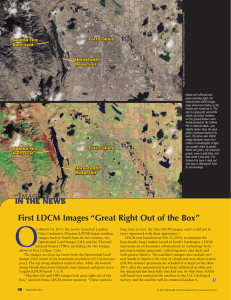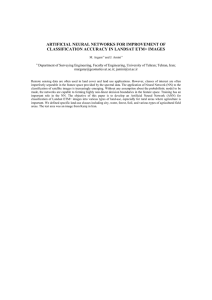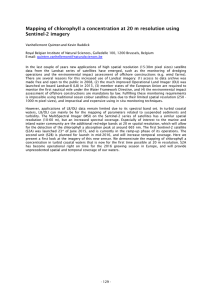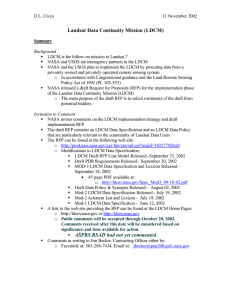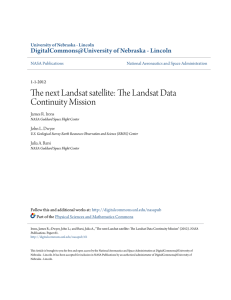The Landsat Data Continuity Mission(LDCM): Landsat 8 Not your
advertisement
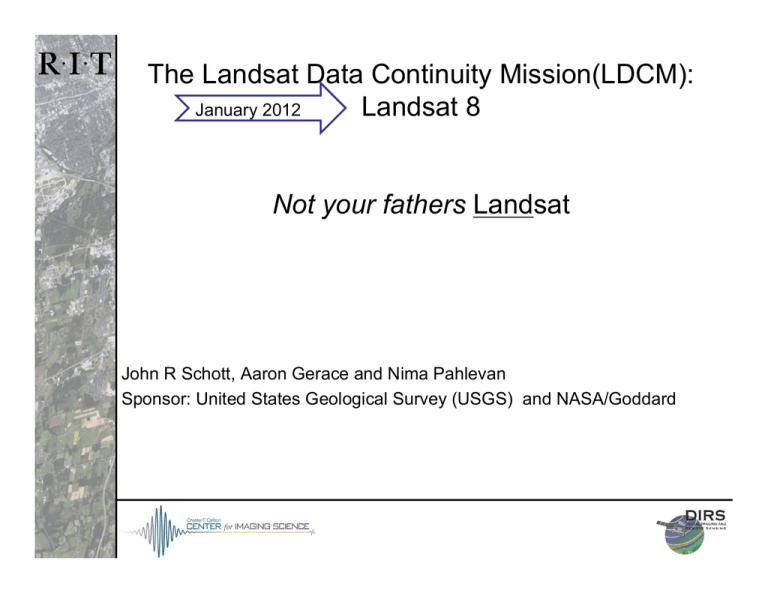
The Landsat Data Continuity Mission(LDCM): January 2012 Landsat 8 Not your fathers Landsat John R Schott, Aaron Gerace and Nima Pahlevan Sponsor: United States Geological Survey (USGS) and NASA/Goddard LDCM carries two pushbroom instruments: The 9 band Orbital Land Imager (OLI) and The 2 band Thermal Infrared Sensor (TIRS) ETM+ • • OLI Same swath width, same resolution as L 7 global coverage, merged OLI-TIRS product 2 Size Matters Rochester Embayment (Lake Ontario) Terra‐MODIS (500m) Landsat 7&8 (30m) Daily coverage 16 day repeat Free web access Free web access 3 3 LDCM Features: New bands LDCM Response 1 Response 0.8 0.6 0.4 0.2 0 350 850 1350 Wavelength 1850 2350 4 LDCM Features: 12 bit Quantization vs. 8 bit on L7 Landsat 7 (8-bit) OLI (12-bit) 5 46 vs. 68 units of chlorophyll OLI’s pushbroom design leads to significantly better SNR Mean/Std SNR for ~ 3% refelector 350 300 250 200 150 100 50 0 Blue Green OLI Red CA L7 NIR 0 1 2 3 4 5 6 Band numbers 6 Modeling the Constituent Retrieval Process: Hydrolight Solar location Sensor location Wind Speed Water IOPs CHL SM CDOM -Absorb -Scatter 7 Modeling the Constituent Retrieval Process: At the Sensor Hydrolight output Sensor response Spectral sampling Add Noise Quantize AVIRIS ETM+ OLI 8 Modeling the Constituent Retrieval Process: CHL Modtran 0 0 0 .5 .5 .5 1 1 .75 3 2 1 5 4 2 7 8 4 12 10 7 24 14 10 46 20 12 68 24 14 M Top of Atmosphere CDOM (g/L) SM (mg/L) CHL=3 SM=4 CDOM=7 CDO M Air/Water Interface CHL 9 Interpolation Process λ TRUE min [(ST - SP)2 ] FALSE LUT SQ Error [CHL] [CHL] [SM] [CDOM] [CDOM ] [ SM ] Sp predicted 10 Modeling the Constituent Retrieval Process: Summary Spectral Hydrolight Sensor Output response sampling AVIRIS X 2000 Add Noise Quantize Constituent retrieval ETM+ OLI – Average residuals can be expressed as a percent of the total range of constituents. CHL [0 – 68], SM [0 – 24], CDOM [0 – 14] – 10% error is our target for this experiment. 11 Results: Perfect atmospheric compensation 12 SNR Margins 13 Results: Perfect atmospheric compensation 14 Atmospheric Compensation Issues Hydrolight-generated water pixels as seen through a 40km visibility atmosphere. • • (Left) TOA Radiance, (Right) Resampled to six LDCM bands. Three Atmospheric compensation algorithms developed to take advantage of deep blue band ,near zero reflectance in NIR/SWIR and model based empirical line method (ELM). 15 OLI Atmospheric Compensation Experiment 3: Real Data 16 Temperature is a driving factor impacting hydrodynamics and therefore materials transport and water quality True Color Composite Thermal Channel Cold center Warm ring • Hydrodynamic models calibrated with surface thermal maps can help bridge temporal gaps and provide estimates of subsurface behavior 17 One Possible Solution to Landsa’st Temporal Resolution – Integrate Landsat data with hydrodynamic (HD) modeling Hydrodynamic modeling, when calibrated, can compensate low temporal resolution of Landsat A well‐calibrated model enables pre‐casting and forecasting of the state of the environment Hydrodynamic models can estimate 3‐D flow and material transport 360‐hours gap of imagery HD Day 1 18 Day 16 18 Hydrodynamic Modeling: Inputs – Nudging Vectors (hourly). • Whole lake simulation provides nudging vectors for small scale simulation. ALGE Hydrodynamic Model Lake Ontario simulation: Surface Currents Landsat 5: July 13th, 2009 19 Collaborations for 2012, 2013 & 2014 Field Seasons 20
